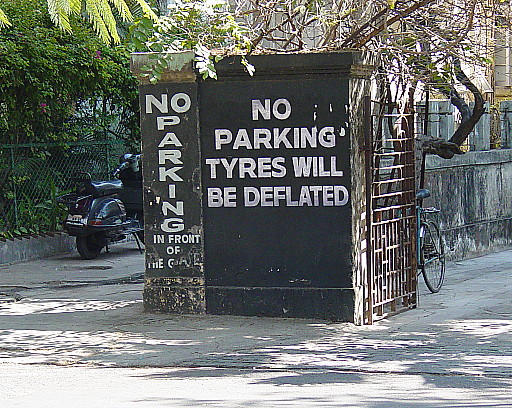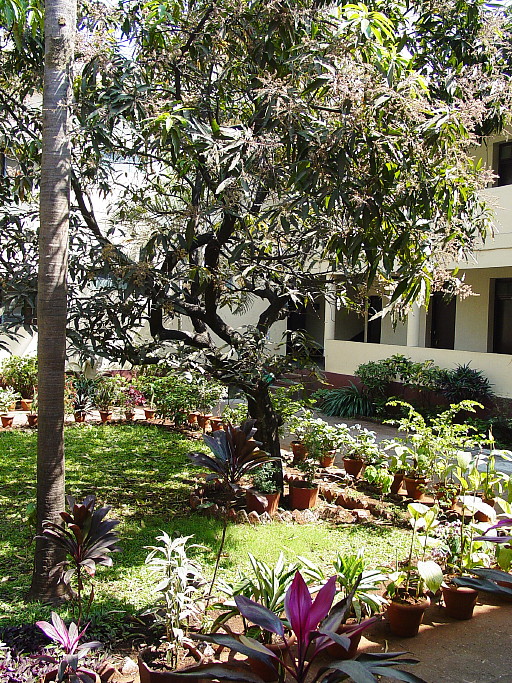First steps in India 2004I am still writing this page. Come back later to read beyond what you find here today. Timetable? Who knows? But there will be more. We made it! Feb. 3: Our ferry tied up alongside of another like it which was tied to another,…. We walked across three other boats like ours to step on the pavement of Mumbai below the huge “Gateway to India” triumphal arch, a relic of the British era. People were everywhere. It was like we were walking through a crowd just leaving a baseball game. It was hot and a bit dirty though nothing like Karachi. Before we walked ten feet, a beggar boy tied a garland of flowers to Petra’s wrist and asked her to buy powdered milk. She tried to reason him out of it—I suspect he understood little. Several other little hands thrust themselves in front of us as we made our way through the crowd in the direction of a hotel. On our second try, at the Garden Hotel, we got a room on the top floor, a nice place to begin our stay in India. It was clean and quiet and the staff friendly. There was even a doorman and an elevator man. After a short rest we walked through town a while to explore. Beggar kids, many of them, asked for rupees and for us to buy milk or balloons. Our Lonely Planet told us of Leopold’s Café and Bar, a tourist hangout since 1871. We went there. Food, atmosphere, and service were good, just the thing to ease us into the culture. We had vegetables in garlic sauce, prawn masala, and beer and loved it. Of course when we returned here a month later after eating around the country, it was a different story; it was so bland. Back in the street we begin to dodge the people and beggars again. Petra tried to reason with them, it was futile. But she was respecting them as persons and talked with them instead of just ignoring them. She even had me at least looking at them when I said no. The street was packed with vendors’ stalls. It made moving tight. I had my hand on my wallet. I was saying, “Excuse me,” every few feet as I brushed and pushed past people. No one else was saying anything and I stopped after a few days. Bumping each other was just part of moving through the streets, no reason to excuse yourself. We slept well that night and learned a new lesson in the morning. A bellboy brought up breakfast, knocked, and walked in before we said or did anything. He didn’t wait for an invite. No embarrassment, we were dressed. But it happened again and again across the country. Private space is defined differently in India. Feb. 4: We ate our breakfast of eggs and toast looking over the city and listening to the contest between the traffic and the crows to see who could be the loudest. Then we headed out to find a new hotel. We tried a couple places but neither would commit to anything before noon—they didn't know whether they would have any free rooms before then. Finally, Bentley’s offered us the interesting proposal of waiting in one room until five and then waiting outside somewhere for a room that wouldn’t be open 10 pm. Someone had reserved the first for a 6 pm arrival so we would have to leave at five. We took it and had a place to rest in an afternoon. As we went from hotel to hotel looking for a room, several times we passed an older shoe wala (a repairman) sitting on a corner beside a wall. Each time we passed he asked, “Shoe Shine?” Once we had the temporary room, Petra returned to him to have her heals replaced. We sat on the side and watched as he cut off the old heals, fashioned new ones, and then glued them on. She could not communicate with him in words nor he with her. But their concerns were passed back and forth with smiles. In the end, Petra left happy with her shoes and the wala sat happy with his payment in hand. All this happened under the watchful eyes of several standers-by. We wandered a while before returning to the hotel to rest until five. Then Petra found a hairdresser and had her hair cut quite well at a corner shop. I spent that time on the internet. Back together, we ate again in a packed Leopold’s. We were still not ready to experience an Indian establishment. Feb. 5: Our Hotel, Bentley’s, was haunted by budget travelers and ex-patriots. Our room was basic with bed, window, and bathroom. After breakfast, Petra checked around the place and spotted a much more spacious room with a balcony looking out over a park, a much homier room. After much give and take with the management, she talked him into giving it to us. It only cost us 100 rupees ($2) more. We sat on the balcony enjoying the lush green plants and white-headed crows a while before heading for a café called Churchill’s which did not live up to its write-up in the Lonely Planet guidebook. So we went back to Leopold’s for a second, more satisfying lunch. Back on the balcony we devised a plan to deal with the beggars. We would get a bunch of five- and ten-rupee coins and give them out when they asked for something. But where would we get the coins? Someone lead us to a shop. The owner counted out 400 rupees in small coins, put them in a bag, and tried to give them to me in exchange for our 500-rupee note. I dumped them out, counted them, and protested. His answer, “You will never get 500 rupees in coins for that note.” We left without his coins, walked down the street to a bank, and got 100 five-rupee coins. He thought he was going to make a few extra rupees from us. During the next days, we gave one or two five-rupees to the beggar kids who come up to us. And some still begged for us to buy milk power “for my baby brother.” This was a scam. They take you to a shop, you buy milk, they take milk, you leave, owner takes back milk, owner gives beggar much less than you gave owner for milk. As the days went on, fewer and fewer beggars approached us. Next attempt for our money: We hired a horse and carriage to take us on a sight-seeing tour for an hour through nearby neighborhoods. As we bargained for a price before starting, a street hustler tried to get into the act. We refused. As we started, he hopped on with driver. He announced he was a guide and we could pay him whatever we wanted at the end. We said we were not interested. As we enjoyed the ride through the streets and along the beach, he continued to tell us about what we were passing. We enjoyed the ride—and gave the hustler nothing at the end. He gambled, lost, and left unhappy. We later found an Australian café with Italian-style coffee and a good western bakery. We drank the first real coffee we had had since leaving Gioia Tauro in Italy. A guard stood duty 24 hours in front of the place. A street vendor tried to sell Petra a map. He had several hanging over his arm. Petra tried to reason with him, “We have no way of carrying a map. Besides, we don’t even have a house to put a map into.” He persisted. Petra continued trying to reason with him. A 72-year-old retiree stepped in and said, “Madam, He will not understand. You must just ignore him.” She said, ”I do not want to ignore anyone.” ”But Madam, just ignore him. You are a visitor. Please, learn from us. I do not want you to talk to the wall.” He had worked in Germany before retiring and had a son in Chicago and a Daughter in New York. Petra smiled at him and at the street vendor and we walked on without a map. Indian bathrooms are different than western ones. The toilet and sink are there along with a shower head but with no shower stall. The water just cascades onto the floor and down the floor drain. As a result, you have to enter without your shoes or risk making a mess from the mud on your shoes. Depending on where you are, you may have an Indian-style toilet instead of an western-style. The Indian version is only a hole in the floor with a flusher. You squat over it. And showers sometimes are only a bucket and a cup. You draw your water, wet yourself with the cup, soap yourself up, and use the cup to rinse yourself. It is actually quite efficient, environmentally sound, and practical when you need to conserve water. Feb. 6: After another breakfast on our balcony, we set out on our next adventure, a taxi to the train station to get a ticket for Lonavla. Traffic was heavy and reckless to our eyes. Often less than an inch separated cars. Our driver often used the second most important part of the car—his horn (obviously, the engine is the most important part). After every signal light turned green, he slammed his car into first and pounded the horn a couple times no matter whether the car ahead of him moved or not. We got to the station finally and then stood in the tourist line for an hour to get a ticket to go only 64 miles (104 kilometers). Before we got out ticket, the agent recorded our passport information and addresses into two big ledger books and had a paper scribbled with notes in addition to having entered much into a computer terminal. As we took our ticket from him, hundreds were standing around waiting for their number to come up so they could get their ticket. It was 1:30. We had arrived around ten.
That's it up till now. I'll add more later. |
 Though this picture is from later, this is the “Gate of India” where we set foot in Mumbai in February. (13 Sept 2004)  Petra sits on our balcony at Bentley’s in Mumbai. A crow with a white collar and some other colorful bird pose in the tree. I could have never made this happen if I had tried to compose it. It just was there.(2 Feb 2004)  They don’t mess around with people parking in front of their driveway in Mumbai. (7 Feb 2004)  The courtyard of Kaivalyadhama Yoga Hospital in Lonavla where we spent four weeks improving out health. (16 Feb 2004)  Our yoga room at Kaivalyadhama. (16 Feb 2004)  Petra stands next to columns carved out of solid rock around the time of Christ. This in the interior of Karla Caves near Lonavla. (11 Feb 2004)  Petra poses after buying her first sari near the Karla Caves. Several women showed her how to put it on. (11 Feb 2004) |
|
Copyright © 2013 Mike Metras and Petra Wolf, PilgrimageCreations.com
|